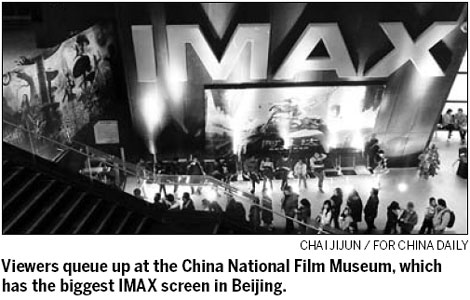Cinema chains ready to cash in on movie boom

New York - Rising income in the country has been fueling a spike in the number of people going to the movies in the past few years, and industry players are set to cash in on the boom.
In the latest signal of growth in the Chinese market, CJ CGV, South Korea's largest multiplex cinema chain, is partnering with IMAX, a Canadian operator of large-screen movie theaters, to install 15 new theaters in China by 2015. The addition will result in 96 IMAX theaters being set up in China, with CJ CGV being the largest operator of IMAX theaters in Asia.
IMAX Chief Executive Officer Richard Gelfond said the company is benefiting from the growth of the sector in China. IMAX's box office revenue in China grew from 10.2 million yuan ($1.5 million) in 2008 to 24.1 million yuan in 2009, and tenfold to 245.5 million yuan in 2010, Gelfond said.
The total box office revenue of China's film industry rose from 4.34 billion in 2008 to 6.21 billion in 2009 to 10.25 billion in 2010, industry figures showed.
To capitalize on the "potential growth" of the cinema industry in China, IMAX is set to share the box office takings of the 15 new Chinese theaters with CJ CGV.
"We think this deal is also significant because, under the terms of the agreement and for the first time in China, IMAX will trade a lower upfront fee than we receive in a typical sales deal in exchange for a larger share of the box office generated by the theater, giving us increased participation in the growing box office in China, which has more than doubled in the country over the last two years," Gelfond said.
In spite of its strong growth, the cinema industry still has a huge untapped market. Gelfond estimated that IMAX will have a total of 20,000 screens in China in five years and 40,000 screens in 10 years, as what the United States has today. Even so, that will be considered a low penetration rate, given the size of China's population.
"Our experience with the IMAX brand and business in South Korea has proven to us that an effective method for us to grow our business in China is to include IMAX in new multiplex locations," said Kim Joo-hyung, chief executive officer of CJ CGV.
"We have been successful with our current IMAX theaters in South Korea and with IMAX's impressive film slate, which is targeted to include mainstream Chinese films, we are pleased to expand our IMAX footprint," said Kim.
Gelfond attributed IMAX's success in China to various factors.
"A big part of our success in China is our brand name and premium viewing quality. It's an affordable luxury, although it costs a bit more than the regular movies. At the same time, income is growing and our brand name is benefiting from the rise of the middle class in China," Gelfond said.
"The government's focus in developing the cinema industry also helps."
Gelfond said China is certainly the company's fastest growing market and expected to see 250 IMAX theaters in the country within the next five years, with 230 to 400 IMAX theaters in the US in the same period.
It could probably take more than five years for China to outgrow the US, "but we started in China only nine years ago compared to the US, which was 40 years ago", Gelfond said.
To cater to local demand in China, IMAX will screen digitally converted Chinese language films. After the success of Aftershock, a co-release with Huayi Brothers, China's largest privately owned media group, IMAX is currently working on releasing John Woo's Flying Tigers at the end of 2011. In the short run, IMAX will screen two Chinese movies a year and in the long run, four to five Chinese movies a year, Gelfond said.
China Daily
(China Daily 09/29/2010 page14)
















